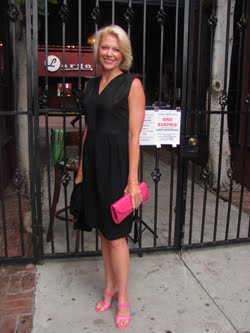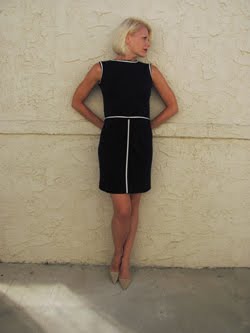For the next month or so, I will be celebrating
Art Deco style on GlamAmor to continue to build excitement toward April's
TCM Classic Film Festival--Style in the Movies. To kick things off and learn more about Deco design, I recently visited
Los Angeles' City Hall--built in 1928--to see a full spectrum of its style through the building's incredible architecture. When it comes to film, though, I could think of nothing better to represent Art Deco than the iconic 1935 musical
Top Hat.
The romantic
Top Hat was shown this week to celebrate Valentine's Day with the silver screen's most sophisticated couple--
Fred Astaire and
Ginger Rogers. The two shared a genuine affection and respect for one another that audiences could feel along with their incredible, if unlikely, screen chemistry. The success in their chemistry came, to paraphrase
Katharine Hepburn, from Fred giving Ginger class while she gave him sex appeal. In any case, it was magic...they ended up making ten movies together and created a look that the world would forever associate with Art Deco style.
All of it really started with the vision of Fred Astaire. He had great control over the style of his pictures. To start, Astaire chose his own clothes for his film wardrobes--both formal and casual. This ended up influencing major changes in 20th century men's fashion. On the formal side, spats, celluloid collars, and other stiff aristocratic styles were on trend at the time. Fred largely rejected this...his own tuxedos represented much more minimalism and, most importantly, allowed him to move. On the casual side, his "Isn't It a Lovely Day (to be Caught in the Rain)" look from
Top Hat established a standard in style that continues to be duplicated by designers today. The outfit is pure Fred--a soft-shouldered tweed sports jacket, button-down shirt, bold striped tie, easy gray flannel trousers, silk paisley pocket square, and suede shoes. Now considered classic, fashion giants like Ralph Lauren and Tommy Hilfiger are
still learning lessons from Astaire's carefully crafted image. He is truly a
GlamAmor-ous Man of Style.
Fred's influence extended to his dancing partners' wardrobes as well. The production process included his advance approval of dresses and would offer suggestions for needed changes during rehearsals as well. Ginger was very interested in costume design, too, and collaborated on much of her incredible
Top Hat wardrobe with Bernard Newman. There was one notable (and now infamous) exception in which Ginger took the lead...her heavenly feathered gown for "Cheek to Cheek." This was a serious point of contention...it was a gown that Ginger largely designed herself and one that Fred did not see until shooting began. To everyone's horror, ostrich feathers ended up flying absolutely everywhere during the dance, causing an enormous rift in the production and such a fight with Fred that Ginger's mother intervened. Though the feathers were sewn on tighter to make it through the production, you can still see some clouds of feathers in the air and floor in the finished film. Knowing the story, though, it's surprisingly hard to spot and the dress is breathtaking in its movement.
Lovingly, Fred's nickname for Ginger became "Feathers" from that point on.
Troubles aside, this was exactly the kind of extreme elegance that makes
Top Hat so iconic. Formal attire was worn throughout the film on sets that took up the bulk of the budget and studio sound stages. These Big White Sets, as they came to be known, represent the Streamline Moderne end of the Art Deco spectrum. You can see the scale of Art Deco in the rooms' high ceilings along with many neo-classical motifs, but the materials, modernity, and sweeping lines of Streamline Moderne are also prominent throughout. The luxurious textiles and their textures in the rooms and clothes--particularly the sparkle and shine of silk and satin--are also pure Art Deco. It's no wonder why Depression-era theater audiences were so in awe.
Top Hat is Fred and Ginger's fourth film, but it is the first that was custom made for them. Along with their trusted team--director Mark Sandrich, cinematographer David Abel, art directors Van Nest Polglase and Carroll Clark, and RKO costume designer
Bernard Newman--they established a style that was very much their own.
Swing Time will be shown at the TCM Classic Film Festival and is another beautiful work, but
Top Hat is really where so much of it started. It stands as an Art Deco masterpiece from the sets to the clothes to the font they use in the titles. So get ready to to take your escape...in
Top Hat.

From the very start of the film, the elegance of the costumes establishes the style
Top Hat purposefully starts with the stuffy (though beautiful) set of the Thackery Club in London
to contrast against the modern style to come
Horace Hardwick (Edward Everett Horton) comes to the club to get his star, Jerry Travers (Fred Astaire),
who can't help but loudly dance on his way out of the quiet club's door
Here we have the first of the iconic Big White Sets--
Art Deco masterpieces with the sweeping lines and materials of Streamline Moderne
One of the reasons for Top Hat's success is its incredible character actors--
both Horton and Eric Blore, who plays the butler Bates, work incredibly well with Astaire
The first musical number--"No Strings (I'm Fancy Free)"--really showcases Astaire's extreme talent...
seguing from speaking into singing (mid-sentence, too) into dancing and having it all seem natural
Like at the Thackery Club, Jerry cannot control his dancing once again
and starts to disturb Dale Tremont (Ginger Rogers) sleeping beneath him in the hotel
The bedrooms are always spectacular in Art Deco films...
just look at those shimmering silks surrounding Ginger as we first meet her
Mistaken identity is the basis for the story in Top Hat and it all starts here...
look at the details--the clock, the lamp, the phone--as Dale calls the manager to complain
Ginger's beautiful lace nightgown is paired with a laced-collar silk charmeuse robe
that pools on the floor when she stands
When Dale meets Jerry...a common introduction in Astaire/Rogers films
is that he bothers her at first, but there's just something she can't resist
Art Deco details--motifs from far off lands like Greece, metals, glass, recessed lighting--
combining with the curvature of Streamline Moderne surround Jerry as he plays Mr. Sandman
Great example of the perfect pairing of the
luminous lighting of David Abel and the set design of Carroll Clark
Jerry gets flowers for Dale from a florist
Wardrobe change for both Ginger and Fred...hers a fitted plaid riding jacket and breeches
and the sports jacket, gray flannels, button-down, and striped tie classic look for men that started with Fred
An on-location shot in London
and we find that Jerry has taken over Dale's taxi to the riding club
"Isn't it a Lovely Day (to be Caught in the Rain)"...Fred was Irving Berlin's favorite singer of his tunes, not bad when Hollywood producers originally declared that he couldn't sing, couldn't act, and was a passable dancer
Another brilliant character actor, Erik Rhodes, plays fashion designer Alberto Beddini
who is paying Dale to model his fabulous clothes all over Europe
Bernard Newman's first gown on behalf of Alberto Beddini...
if it doesn't have sparkle and shine, it's not an Art Deco movie
Here we can see ships as an Art Deco motif in the painting
and a sweeping staircase that is similar to the one I saw at
City Hall
The misunderstanding continues and Dale expresses her hatred of men...
her gown looks like a silk slipdress with gold lame straps, and a glittering ruffled transparent layer on top
A traveling suit topped with a chevron striped cape...
great gloves, hat, and handbag (possibly black corde) as well
Warming up to do his show, Jerry hears that Dale has left for Venice...
look at all the details on the dresser
The iconic "Top Hat" musical number...Fred was Irving Berlin's favorite singer of his tunes,
not bad when Hollywood producers originally declared that he couldn't sing, couldn't act, and was a passable dancer
Gene Kelly once said that modern dance on film started with Fred Astaire...
I'm struck by how many (such as Michael Jackson) were influenced by and often imitated his style
Top Hat is the first time on film that Fred uses a cane as a prop
and here is when he famously "shoots" his dancers down with it
This may be the Big White Set of them all...
the Art Deco version of Venice
Dale walking down the steps with Alberto
in a very jaunty belted jumper, shortsleeve cover up, strappy flat sandals, and tote
Dale meets up with best friend and Horace's wife, Madge Hardwick (Helen Broderick),
who looks very sporty as well especially with that beret
Interesting how the polkadot material comes through the coat
Even while stowing away on a seaplane to Venice,
the whole scene--clothes and set--is immaculate
Wardrobe change to meet the guys getting off the plane...
a very 20s cut gown for Madge and an over-the-top black gown (for day!) and hat
Another iconic Big White Set--when the boys are forced to bunk in the bridal suite of the hotel...
look at that bedroom!
Meanwhile the girls gab in their own suite as the misunderstanding continues
Back into a tuxedo with tails to strategize for dinner
with Horace in his hotel room's great Art Deco bathroom
Though glamorous, I've often wanted to see what this gown would look like without the sheer sleeves
Venice at night...a restaurant along the water of the canal (dyed black to deepen contrast)
Ginger looks luminous in this scene (I love her makeup and lighting)
as Fred gets ready to dance with her "Cheek to Cheek"
More of Venice Big White Set--includes a stairway, flat bridge to dance across over the canal,
and a terrace that likely took up an entire sound stage on its own
Though tales abound of the terror of those feathers,
it is breathtaking to watch Ginger float around in them
Bringing bias-cut silk together with feathers is very popular in 1930s gowns...
In addition to all the dancing, another moment to cheer the great direction of Mark Sandrich
Dale's added a silk wrap around her shoulders as she calls Madge
who wears another drop-waist dress with loads of Art Deco jewelry--bracelets and clips on neckline
And a backless gown even for Madge...
as she tells the boys that Dale has decided to marry Alberto
Asian-inspired loungewear--the cut, the fabric, even the fasteners--speaks to the
fascination with travel and archeology during the Art Deco period
Once again, Jerry can't control his tapping and uses it to steal Dale away from Alberto
A dance to the "Piccolino" is about to take the place of a wedding march
Last time this type of Busby Berkeley-esque production would appear in an Astaire film...
it was more modern to integrate all songs and dances into the plot to take the story forward
As with all the dresses Ginger would wear (and Fred would approve)
this one had such surprises in its incredible movement
Top Hat ends with Fred wearing one of his own with his overcoat
and Ginger pairs her sparkling gown with a white fur
For the best selection of Fred Astaire and Ginger Rogers classics, be sure to visit the
TCM Shop!




































































































































































































































